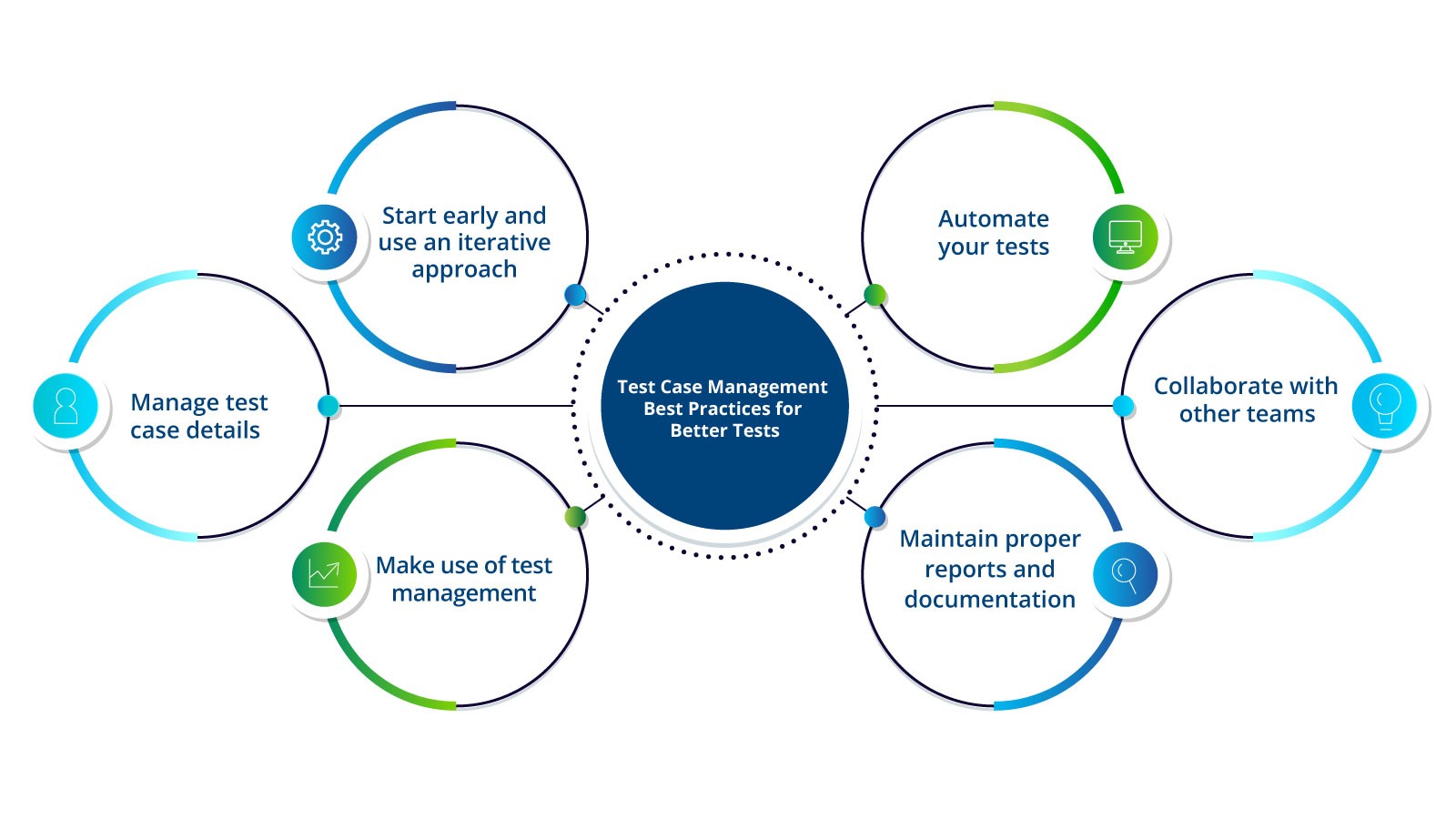Test case management is the management of testing activities for software development. This includes preparing for the test life cycle, distributing time and resources, and writing and executing test cases to detect problems in time. Effective testing is vital for creating high-performing applications that satisfy end customers. Here are some tips and best practices that are essential for test management today:
Tests should be conducted proactively throughout the software development cycle. An iterative approach to testing and development introduces incremental improvements in product performance. Leaving testing to the last stages can cause delays and increase time-to-market, creating client discontent and mistrust. On the other hand, continuous testing ensures that defects can be identified and corrected in time. By conducting development and testing simultaneously, developers no longer have to wait for the completion of the testing phase before making changes. This helps save money and effort in the long run.
Testers should classify all information and data in detail. Well-written and well-organized test cases are crucial to effective test case management. Each test case should be given a unique name, ID, and description. Test cases should contain clearly defined preconditions and prerequisites, exact instructions with minimal and simple steps, and required and expected results. As test data increases, organizing test cases becomes especially critical. Otherwise, testers can get swamped with large amounts of confusing information. Consistently logging details and categorizing test cases makes it easier to evaluate data and filter for specific information and insights.
Test management tools can streamline testing processes and efforts. Testers can use these tools to assign tasks easily, track progress through real-time data, and produce customized reports. They can also filter data and use visual aids such as graphs and charts to display summarized results and quick overviews. The best test management tools also offer a range of third-party integrations with other tools and software for smoother workflows. Additionally, working through a single platform enhances collaboration and communication. All the relevant stakeholders can track testing activities and progress without having to go through the process of sending individual reports.
Testworthy is one of the best test management tools to help you in your testing journey. Minimize individual efforts and expenses associated with test case management with Testworthy - a one-stop solution to help you optimize your testing processes for quick and flawless software delivery. Sign up for your free trial now.
Testers should maintain proper documentation throughout the project timeline. Before testing, it is important to define the testing strategy, policies, plans, etc. Teams should finalize and record project requirements beforehand to ensure that everyone is working towards the same goals and outcomes. During the development and testing cycles, testers should maintain a log of all processes and progress reports, i.e., the status of various testing tasks, work assignments, failure and pass rates, and any bottlenecks and issues encountered. Information should be updated in real-time to keep track of changes. Post-testing documentation includes generating customizable reports to identify patterns and deliver actionable insights for future development.
Teamwork is an important aspect of test case management. Testing teams should not work in silos, but collaborate with developers, project managers, business analysts, and clients. QAs should attend client meetings to obtain full clarity on all technical and business requirements. They should work with developers to create relevant test cases to identify and solve issues in time. Testers also need to coordinate closely with each other. For example, by sharing information and maintaining up-to-date centralized test case repositories, testers can facilitate each other by enabling easy test execution and avoiding test duplication. Test management tools are an effective method to enable and encourage close collaboration of relevant stakeholders.
Test automation accelerates testing processes, maximizes test coverage, and improves efficiency. Automated tests are easily scalable and can be run repeatedly without extra costs, allowing for efficient use of time and resources as the testing load increases. Automating repetitive tasks minimizes human exertion and frees up resources so that they can be reallocated to better work. Automation also eliminates human error, leading to greater accuracy and precision in results. However, it is important to keep in mind that not every test needs to be automated. For example, usability and exploratory testing are best done manually and do not require automation. Additionally, automation can be costly and is not always feasible. Tests should only be automated if the benefits outweigh the related costs.
Testing is a fundamental stage of the software development process, so testing activities must be thoroughly planned out and managed. Following the best practices for test case management can help ensure that testing procedures are well-coordinated and organized, resulting in efficient processes that enhance business value and lead to the creation of quality products.

Start early and use an iterative approach
Tests should be conducted proactively throughout the software development cycle. An iterative approach to testing and development introduces incremental improvements in product performance. Leaving testing to the last stages can cause delays and increase time-to-market, creating client discontent and mistrust. On the other hand, continuous testing ensures that defects can be identified and corrected in time. By conducting development and testing simultaneously, developers no longer have to wait for the completion of the testing phase before making changes. This helps save money and effort in the long run.
Manage test case details
Testers should classify all information and data in detail. Well-written and well-organized test cases are crucial to effective test case management. Each test case should be given a unique name, ID, and description. Test cases should contain clearly defined preconditions and prerequisites, exact instructions with minimal and simple steps, and required and expected results. As test data increases, organizing test cases becomes especially critical. Otherwise, testers can get swamped with large amounts of confusing information. Consistently logging details and categorizing test cases makes it easier to evaluate data and filter for specific information and insights.
Make use of test management tools
Test management tools can streamline testing processes and efforts. Testers can use these tools to assign tasks easily, track progress through real-time data, and produce customized reports. They can also filter data and use visual aids such as graphs and charts to display summarized results and quick overviews. The best test management tools also offer a range of third-party integrations with other tools and software for smoother workflows. Additionally, working through a single platform enhances collaboration and communication. All the relevant stakeholders can track testing activities and progress without having to go through the process of sending individual reports.
Testworthy is one of the best test management tools to help you in your testing journey. Minimize individual efforts and expenses associated with test case management with Testworthy - a one-stop solution to help you optimize your testing processes for quick and flawless software delivery. Sign up for your free trial now.
Maintain proper reports and documents
Testers should maintain proper documentation throughout the project timeline. Before testing, it is important to define the testing strategy, policies, plans, etc. Teams should finalize and record project requirements beforehand to ensure that everyone is working towards the same goals and outcomes. During the development and testing cycles, testers should maintain a log of all processes and progress reports, i.e., the status of various testing tasks, work assignments, failure and pass rates, and any bottlenecks and issues encountered. Information should be updated in real-time to keep track of changes. Post-testing documentation includes generating customizable reports to identify patterns and deliver actionable insights for future development.

Collaborate with other teams
Teamwork is an important aspect of test case management. Testing teams should not work in silos, but collaborate with developers, project managers, business analysts, and clients. QAs should attend client meetings to obtain full clarity on all technical and business requirements. They should work with developers to create relevant test cases to identify and solve issues in time. Testers also need to coordinate closely with each other. For example, by sharing information and maintaining up-to-date centralized test case repositories, testers can facilitate each other by enabling easy test execution and avoiding test duplication. Test management tools are an effective method to enable and encourage close collaboration of relevant stakeholders.
Automate your tests
Test automation accelerates testing processes, maximizes test coverage, and improves efficiency. Automated tests are easily scalable and can be run repeatedly without extra costs, allowing for efficient use of time and resources as the testing load increases. Automating repetitive tasks minimizes human exertion and frees up resources so that they can be reallocated to better work. Automation also eliminates human error, leading to greater accuracy and precision in results. However, it is important to keep in mind that not every test needs to be automated. For example, usability and exploratory testing are best done manually and do not require automation. Additionally, automation can be costly and is not always feasible. Tests should only be automated if the benefits outweigh the related costs.
Conclusion
Testing is a fundamental stage of the software development process, so testing activities must be thoroughly planned out and managed. Following the best practices for test case management can help ensure that testing procedures are well-coordinated and organized, resulting in efficient processes that enhance business value and lead to the creation of quality products.
FAQs
Testworthy is the only tool you should consider for test case management and maintenance. It offers a wide range of testing and QA tools that'll help you expertly spot bugs in programs and remove them efficiently to deliver flawless digital products.
Testworthy is the best tool for Jira integration. With a plethora of tools and insights, Testworthy helps enhance your teams' productivity and collaboration. You can create data-driven reports with your Jira data and push detailed bug reports.
Unit testing, integration testing, system testing, and acceptance testing are the four levels of software testing. Each level evaluates different aspects of the software and builds on the previously tested levels.